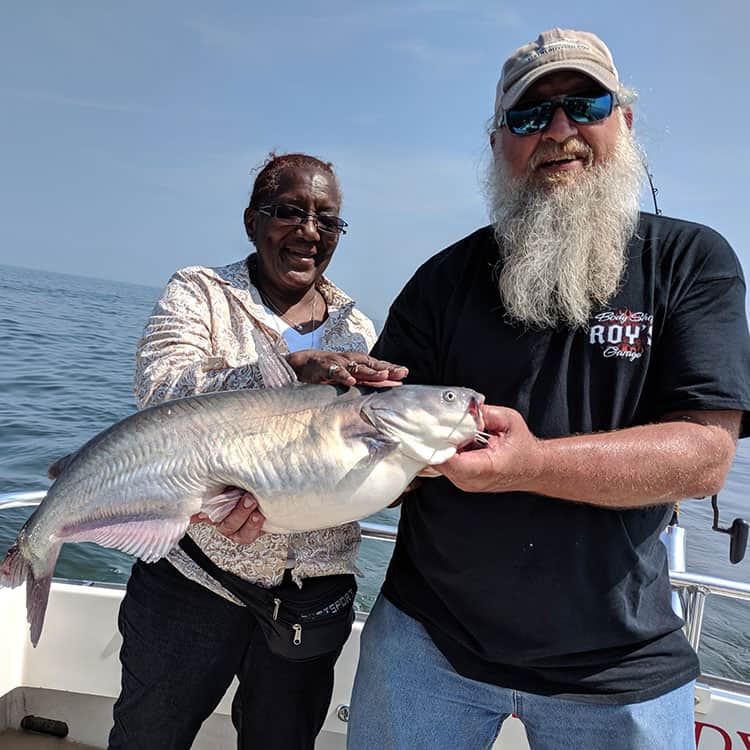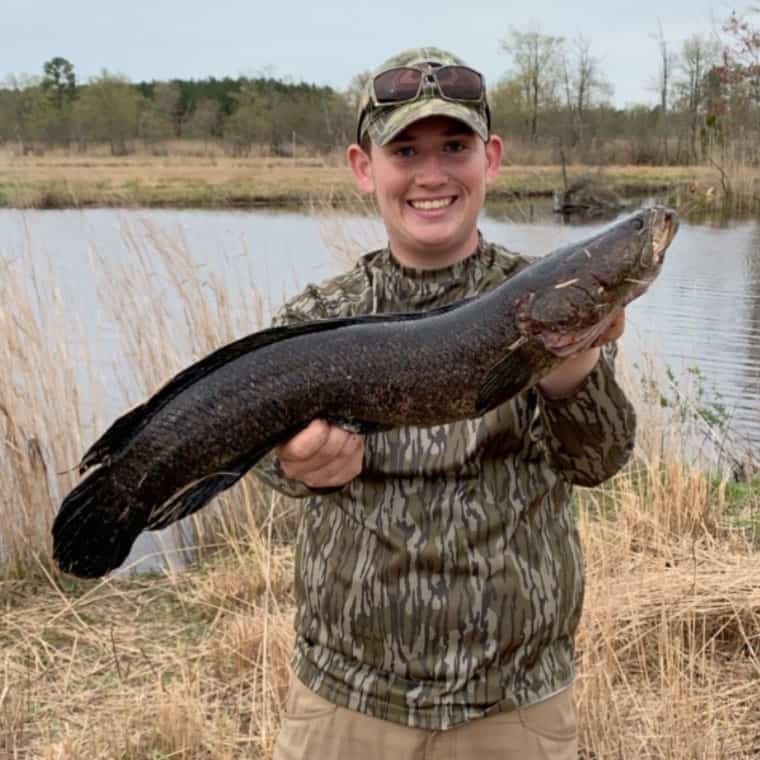A Chesapeake Perspective
Impacts & Opportunities of Invasive Fish in Chesapeake Bay
Posted on: Apr 12, 2023
The adage that beauty is in the eye of the beholder is never more true among anglers. Many couldn’t care less if a game fish looks like it’s been run through the garbage disposal, so long as it bends their rod and punishes their reel’s drag. And if the fish tastes good, well, that’s a bonus. As proof, I give you the northern snakehead and the blue catfish.
A white-hot topic across the nation’s fishery world is the impact non-native fish like snakes and bluecats are having on regional and local ecosystems. For more than a decade, Chesapeake fishery managers and the sport fishing community have been grappling with the best ways to limit the impact blue cats and snakeheads have on native fish. However, the evidence is compelling that in some Bay waterways blue catfish and northern snakeheads are increasingly hurting native fish populations. Of particular concern are blue crabs and rockfish (stripers), two of the Bay’s most culturally and economically valuable species.
Behold the Behemoth Blue Catfish
Because blue catfish thrive in various conditions, their range has expanded throughout the Bay’s tidal waters. They are anything but picking eaters, chowing down on a variety of native Chesapeake species including menhaden, stripers, eel, shad, river herring, and blue crabs. In fact, recent studies have shown that blue catfish can consume one to one-and-a-half blue crabs per day.

From an angler’s perspective, the James and Potomac rivers are world-renowned for holding monster blue cats. Scores of guide services in both Virginia and Maryland specialize in catching trophy blues. The popularity of trophy catfishing is easy to understand: The sheer power of these freshwater fish is incredible. Landing blue cats better than 50 pounds is not uncommon. In fact, Virginia’s Kerr Lake is home to the world record blue catfish: An eye-popping 143 pounder caught by Nick Anderson.
Blue catfish are native to the Mississippi River and were introduced to the James and Rappahannock rivers in the 1970s to spark a recreational fishery. In the decades since, they have spread throughout the tidal portion of Bay, especially northward, much to the delight of some sport anglers. Fisheries biologists, however, are not as enthused.
One can appreciate the tricky spot Bay fishery professionals are in: On the one hand, there is real value (economic, recreational) in promoting recreational fishing for trophy catfish. From an ecological perspective, however, subduing invasives is necessary albeit a heavy lift.
To help address this threat, earlier this spring Maryland Gov. Moore’s Administration issued a formal request to the U.S. Secretary of Commerce asking the agency to declare a federal fisheries disaster as a result of the negative impacts that invasive catfish and snakeheads create in Chesapeake Bay. If granted, the result could be an infusion of federal funding to help reduce the impact of these invasive species on important Maryland fisheries. CCA Maryland fully supports Gov. Moore’s decision to pursue federal support to address the serious problems invasive catfish and snakeheads create in Chesapeake Bay and its tributaries.
Chasing the Northern Snakehead
It’s crazy to think that almost twenty years ago snakeheads were discovered in a suburban Maryland pond. In that time, these apex predators have exploded in scores of Bay tributaries and threaten important freshwater species including largemouth bass and white and yellow perch that share similar habitats.
Once demonized as an invasive species so potentially dangerous, a biologist at that time predicted if left unchecked these fish would decimate native Chesapeake species. That didn’t happen, and today they’re found throughout Maryland waters and beyond. The state’s DNR has softened its position from the early years of “kill it on sight!” to allow the release of snakeheads as long as anglers do it “directly back into the waters from which it came.” Yes, fish biologists and conservationists definitely still want to slow the spread of these top predators, primarily via tournaments and strongly encouraging anglers to kill every snakehead caught.

Natural resource agencies in Maryland and Virginia continue to do their due diligence by tracking its populations and educating the fishing public to help reduce snakeheads’ impact on native species such as white and yellow perch. As the years click by, they also understand the reality on the water. Complete eradication is not only unrealistic, it would also cripple a recreational fishery that is very popular.
Anglers love to fish for snakeheads because they’re voracious fighters on light tackle and exceptional table fare. Filleted, they’re similar to rockfish. Like blue catfish, you can keep as many as you want and there is no minimum size.
Well-known snakehead grounds include the tributaries of the Potomac and the Blackwater area on the Eastern Shore. But their range is much more extensive, and they’ve also been caught in neighborhood ponds and creeks so skinny and narrow at first glance you’d think nothing could swim in there. The popularity of snakehead fishing for snakehead among the recreational fishing community ranges from the casual to the fanatic. Tournaments and small businesses have sprung around this non-native fish on both sides of the Bay.
There is no shortage of opinions on what lure and tactics work best to catch a snakehead. Most would agree that topwater lures are the most fun, As water temperatures warms, noisy surface lures cause a lot of commotion, and that seems to be what the snakeheads want. Topwater lures that mimic frogs are top sellers, though chatterbaits are top-notch, too.
What CCA Maryland is Doing
CCA is taking a leading role to help fishery managers better understand which invasive species are being caught and where to support the science based management of our natural resources. Our “Great Chesapeake Invasives Count” helps provide fishery managers with more data – while anglers compete for great prizes! – they need to better understand which invasive species are being caught and where they are, to support the science-based management of our natural resources. It’s a win-win.
CCA and its partners are also hosting the second season of Chesapeake Perspective with three thought-provoking seminars that are sure to spark innovative and move forward real solutions to some of the most pressing issues confronting Chesapeake recreational anglers. The first seminar will be live streamed at 7 p.m. on Thursday April 20.
Each event, moderated by FishTalk Angler-in-Chief Lenny Rudow, features a lively discussion by an expert panel, each participant a leader from the Chesapeake Bay and Atlantic region. Viewers can ask questions during the live stream via Facebook on YouTube. We kick things off on April 20 with “Opportunities and Impacts of Invasive Fish,” followed by “Expanding Angler Access” on June 15, and the third in the series takes place on Sept. 21 with “Habitat Preservation and Restoration. Registration is free.

Capt. Chris C. Dollar
Chesapeake native Captain Chris Dollar is a lifelong conservationist, outdoor columnist and fishing outfitter with nearly 30 years' experience avoiding office work.
